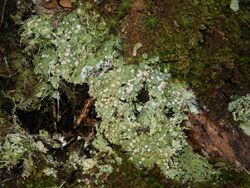Biology:Icmadophilaceae
| Icmadophilaceae | |
|---|---|

| |
| Icmadophila ericetorum | |
| Scientific classification | |
| Domain: | Eukaryota |
| Kingdom: | Fungi |
| Division: | Ascomycota |
| Class: | Lecanoromycetes |
| Order: | Pertusariales |
| Family: | Icmadophilaceae Triebel (1993) |
| Type genus | |
| Icmadophila Trevis. (1853)
| |
| Genera | |
|
Dibaeis | |
The Icmadophilaceae are a family of lichen-forming fungi in the order Pertusariales. The family was circumscribed in 1993 by the mycologist Dagmar Treibel.[1] It contains 9 genera and 35 species.[2]
Description
Icmadophilaceae species are usually crust-like to shrub-like in form. Their [[Glossary of lichen terms#{{biology:{1}}}|{{Biology:{1}}}]] partner is [[Glossary of lichen terms#{{biology:{1}}}|{{Biology:{1}}}]], which is crucial for their survival. Their apothecia (fruiiting bodies) are typically [[Glossary of lichen terms#{{biology:{1}}}|{{Biology:{1}}}]] in form, meaning they have a light-coloured (not [[Glossary of lichen terms#{{biology:{1}}}|{{Biology:{1}}}]]) margin, and are often pink in colour. Some may have stalk-like structures, referred to as [[Glossary of lichen terms#{{biology:{1}}}|{{Biology:{1}}}]].[3]
Within these reproductive structures, Icmadophilaceae lichens have unbranched filaments called paraphyses, which are amyloid. The asci, or spore sacs, in these lichens are thin-walled and lack a thickened top section (apical [[Glossary of lichen terms#{{biology:{1}}}|{{Biology:{1}}}]]) but have a thin, amyloid cap at their tips. They are typically cylindrical in shape.[3]
Each ascus typically contains eight spores. These spores come in various shapes – ellipsoid, oblong, [[Glossary of lichen terms#{{biology:{1}}}|{{Biology:{1}}}]] (spindle-shaped), to cutriform (knife-shaped) – and are clear (hyaline) and non-amyloid. In addition to spore reproduction, Icmadophilaceae lichens can also reproduce asexually through structures called pycnidia, which produce rod-shaped (bacillar), hyaline conidia (asexual spores).[3]
In terms of chemical composition, this family is characterised by a variety of depsides, a type of secondary metabolite (lichen product) commonly found in lichens.[3]
Genera
- Dibaeis Clem. (1909)[4] – ca. 14 spp.
- Endocena Cromb. (1876)[5] – 2 spp.
- Icmadophila Trevis. (1852)[6] – 4 spp.
- Knightiellastrum L.Ludw. & Kantvilas (2020[7] – 1 sp.
- Pseudobaeomyces M.Satô (1940) – 2 spp.
- Siphula Fr. (1831)[8] – 26 spp.
- Siphulella Kantvilas, Elix & P.James (1992)[9] – 1 sp.
- Siphulopsis Kantvilas & A.R.Nilsen (2020)[7] – 1 sp.
- Thamnolia Ach. ex Schaerer (1850) – 4 spp.
References
- ↑ Rambold, G.; Triebel, D.; Hertel, H. (1993). "Icmadophilaceae, a new family in the Leotiales". Phytochemistry and Chemotaxonomy of Lichenized Ascomycetes – A Festschrift in Honour of Siegfried Huneck. Bibliotheca Lichenologica. 53. Berlin/Stuttgart: J. Cramer. pp. 217–240.
- ↑ "Icmadophilaceae". Catalogue of Life. https://www.catalogueoflife.org/data/taxon/BCW.
- ↑ 3.0 3.1 3.2 3.3 Jaklitsch, Walter; Baral, Hans-Otto; Lücking, Robert; Lumbsch, H. Thorsten (2016). Syllabus of Plant Families: Adolf Engler's Syllabus der Pflanzenfamilien. 1/2 (13 ed.). Berlin Stuttgart: Gebr. Borntraeger Verlagsbuchhandlung, Borntraeger Science Publishers. p. 148. ISBN 978-3-443-01089-8. OCLC 429208213.
- ↑ Clements, F.E. (1909). The Genera of Fungi. Minneapolis, Minnesota: The H. W. Wilson Company. pp. 78, 175. https://archive.org/details/cu31924086708561/page/n5/mode/2up?ref=ol&view=theater.
- ↑ Crombie, J.M. (1876). "On the Lichens collected by Professor R. O. Cunningham in the Falkland Islands, Fuegia, Patagonia, and the Island of Chiloe during the Voyage of H.M.S. 'Nassau', 1867–9". The Journal of the Linnean Society. Botany 15: 222–234. https://www.biodiversitylibrary.org/page/223907.
- ↑ Trevisan, V. (1852). "Saggio di una classazione naturale dei Licheni. - Memoria I. Sulla tribu delle Patellariee" (in it). Revista Periodica dei Lavori della Imperiale Regia Accademia di Padova 1 (3): 237–271.
- ↑ 7.0 7.1 Ludwig, Lars R.; Kantvilas, Gintaras; Nilsen, Andy R.; Orlovich, David A.; Ohmura, Yoshihito; Summerfield, Tina C.; Wilk, Karina; Lord, Janice M. (2020). "A molecular-genetic reassessment of the circumscription of the lichen genus Icmadophila". The Lichenologist 52 (3): 213–220. doi:10.1017/S0024282920000122.
- ↑ Fries, E.M. (1831) (in la). Lichenographia Europaea Reformata. pp. 7, 406.
- ↑ Kantvilas, Gintaras; Elix, John A.; James, Peter W. (1992). "Siphulella, a new lichen genus from southwest Tasmania". The Bryologist 95 (2): 186–191. doi:10.2307/3243434.
Wikidata ☰ Q3147725 entry
 |

